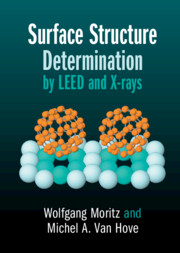Book contents
- Surface Structure Determination by LEED and X-rays
- Surface Structure Determination by LEED and X-rays
- Copyright page
- Contents
- Preface
- List of Abbreviations
- List of Major Symbols
- Glossary
- 1 Introduction
- 2 Basic Elements
- 3 LEED Experiment
- 4 Interpretation of the Diffraction Pattern
- 5 LEED Theory
- 6 LEED Theory
- 7 Surface X-ray Diffraction
- Appendices
- References
- Index
4 - Interpretation of the Diffraction Pattern
Published online by Cambridge University Press: 18 August 2022
- Surface Structure Determination by LEED and X-rays
- Surface Structure Determination by LEED and X-rays
- Copyright page
- Contents
- Preface
- List of Abbreviations
- List of Major Symbols
- Glossary
- 1 Introduction
- 2 Basic Elements
- 3 LEED Experiment
- 4 Interpretation of the Diffraction Pattern
- 5 LEED Theory
- 6 LEED Theory
- 7 Surface X-ray Diffraction
- Appendices
- References
- Index
Summary
LEED has found widespread application in surface science, since the LEED experiment can be performed in a small laboratory and LEED systems are commercially available. A main advantage compared to surface X-ray diffraction is that on the LEED screen most of the 2-D diffraction pattern is visible, thus allowing a quick and comprehensive overview of the symmetry and to some extent about the degree of ordering of the surface under examination. A LEED system is therefore included in most UHV chambers to control the quality of the surface preparation for a wide range of surface studies. A qualitative interpretation of the diffraction pattern is the most common use of LEED: it allows the identification of the surface unit cell, the estimation of the degree of ordering and the identification of different surface phases in adsorption systems (and thereby often a check on adsorbate coverage). The diffraction pattern thus reflects the translational symmetry and the crystalline order of the surface.
- Type
- Chapter
- Information
- Surface Structure Determination by LEED and X-rays , pp. 85 - 109Publisher: Cambridge University PressPrint publication year: 2022

